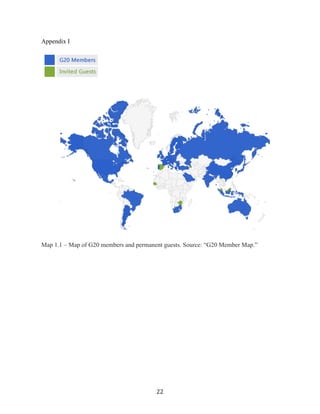1) The 2014 G20 Summit in Brisbane marked a turning point where the G20 shifted its focus from reacting to the Global Financial Crisis to proactively setting an agenda for future global economic growth.
2) Australia, under its G20 presidency, aimed to revitalize the G20 and strengthen it as a forum for international cooperation. The country pushed for specific targets and accountability.
3) The summit succeeded in laying the groundwork for new initiatives and strategies to raise global growth and standards of living through commitments around issues like investment, infrastructure, and employment. This represented a shift from past summits that focused on reaffirming old commitments.
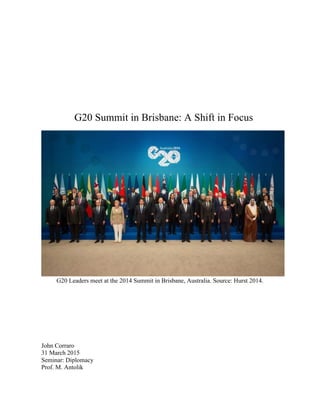

![3
Joseph Hockey (2014), “the challenges and opportunities of our age are intrinsically global in
nature [and] they require a global response.” That is just what Australia hoped to produce
through its leadership of the G20. A global response with clear targets and deliverables was
key to the Australian presidency amidst “criticism that the November 2014 Brisbane
Summit…[would] just be a ‘talkfest.’” No longer would “the G20’s relevance and influence
in the crowded international governance space be put into question.” No longer would global
players be left “wondering whether there is a role for the G20 to play in the future or whether
it is simply duplicating the work of other more-effective organizations” (Committee for
Economic Development of Australia 2014, 6). Not under Australia’s presidency. This
presidency saw goals to revitalize and refocus the G20 and to strengthen this fundamental
“mechanism of international cooperation” (Hockey 2014). Australia’s pragmatic approach to
the leadership of the G20 came at a critical time. Had another country been in the presidency
position, perhaps the necessary change in operations would not have occurred and individuals
would have continued to criticize the group. Without the presidency’s initiative and desire to
revitalize the G20, it is unclear whether or not it could have proved itself to be such a
necessary global body.
Following the summit, Australian Prime Minster, Tony Abbott, said in a press
conference, “I believe that the G20 this weekend has shifted a gear from responding to events
to setting an agenda for growth” (G20 Policy Division 2014, 2). As referenced by Prime
Minister Abbott, the 2014 summit in Brisbane lived up to Australia’s ambitious goals and
proved to be a turning point for the G20. The member countries not only reaffirmed their
commitment to reform and recovery for the world financial systems but also laid the
groundwork, through countless initiatives and strategies, to “raise global growth and deliver](https://image.slidesharecdn.com/ad9efdc2-b46b-4ff4-a79e-bf93930c3f90-150529212347-lva1-app6891/85/Senior-Thesis-3-320.jpg)
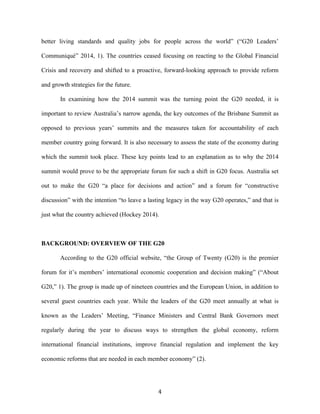
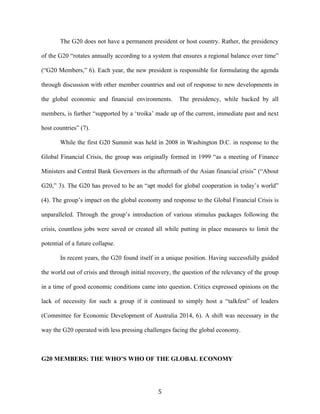
![6
As previously stated, the G20 is made up of nineteen countries and the European
Union. The members of the group represent “a mix of the world’s largest advanced and
emerging economies, representing about two-thirds of the world’s population, 85 per cent of
global gross domestic product and over 75 per cent of global trade” (“G20 Members,” 1).
These member countries are Argentina, Australia, Brazil, Canada, China, France, Germany,
India, Indonesia, Italy, Japan, Republic of Korea, Mexico, Russia, Saudi Arabia, South Africa,
Turkey, the United Kingdom, the United States and the European Union (2).
In addition to the member countries, the G20’s 5th
Anniversary Vision Statement
incudes a commitment to engage with global institutions and non-member countries,
recognizing the importance of G20 growth activity to the rest of the globalized world.
Each year, the G20 president invites several guest countries and all members “engage
with [these] and other non-member countries to ensure the G20 reflects a broad range of
international opinion” (“G20 Members,” 3). Guests typically include “Spain, a permanent
invitee; the Chair of ASEAN; Global Governance Group; two African countries, the chair of
the African Union and a representative of the New Partnership for Africa’s
Development…and a country or countries invited by the presidency, usually from its own
region” (“G20 and The World,” 5). Past guests have included Benin, Brunei, Cambodia,
Chile, Colombia, Equatorial Guinea, Ethiopia, Kazakhstan, Malawi, the Netherlands, Spain,
Switzerland, Thailand, the United Arab Emirates, Vietnam, Mauritania, Senegal, Myanmar
and New Zealand (5). For a map of member countries and invited guests, see Map 1.1 in
Appendix I.
While Leaders, Finance Ministers and Central Bank Governors all play a vital role in
the G20, the group would not be complete without representation from various international](https://image.slidesharecdn.com/ad9efdc2-b46b-4ff4-a79e-bf93930c3f90-150529212347-lva1-app6891/85/Senior-Thesis-6-320.jpg)

![8
summit. The summit also marked the 5th
Anniversary of the G20 Leaders Meeting, in which
all leaders reaffirmed their convictions of a “closer partnership and collective action and
shared responsibility of the G20, based on effective policy coordination [towards] sustainable
growth and rising prosperity for all” (“2013 St. Petersburg,” 5).
In 2012, the G20 Summit was held in Los Cabos, Mexico with few significant
outcomes from the member countries. Aside from “the establishment of country-specific
measures each G20 member would take to strengthen demand, growth, confidence and
financial stability under the Los Cabos Growth and Jobs Action Plan,” member countries
reaffirmed old pledges and charged international organizations with analysis “of the impact
on global value chains of restrictive trade and investment measures” (“2012 Los Cabos,” 1).
One of the few initiatives that were launched in 2012 was AgResults, which was co-
sponsored by Australia. The initiative aimed at enhancing food security for the poor and was
backed with Australia’s commitment of A$20 million (“2012 Los Cabos,” 1). Australia’s role
in this initiative is a foreshadowing of its desire to emerge as an effective global player, with
sights set on the G20 presidency two years down the line.
In both of these summits, St. Petersburg and Los Cabos, a Leaders’ Declaration was
released at the conclusion. These long, verbose documents were commonly produced after
each summit. In 2014, however, Australia aimed for “a communiqué just three pages long
explaining precisely how good intentions are being put into practice” (Abbott 2014b, 59).
This was just one of Australia’s reforms to the way the G20 operates.
AUSTRALIAN PRESIDENCY: A FOCUS ON CHANGE
The history of the G20 can be broken up into three phases. The first phase was the](https://image.slidesharecdn.com/ad9efdc2-b46b-4ff4-a79e-bf93930c3f90-150529212347-lva1-app6891/85/Senior-Thesis-8-320.jpg)

![10
At the start of its presidency, Australia welcomed the opportunity to “lead and
influence the world’s collective decision-making on how to get the global economy growing,
how to make it resilient to future shocks and how to continue to build sustainable prosperity
for all the citizens of the world” (Hockey 2014). Australia entered the 2014 presidency with
the ambition to lead by example. The country boasted twenty-three years of growth and a
strong record of economic and fiscal reform, according to Treasurer Hockey (2014). Australia
emerged from the Global Financial Crisis in better shape than many of the other G20
countries, as the economy in Australia did not experience the same dramatic downward spiral
that many others did. This positive history and openness to reform allowed Australia to
promote the reform the other member countries needed and offered Australia a test of their
influence on a global scale. Dr. Fullilove (2014), of the Lowy Institute remarked,
The G20 is profoundly important to [Australia]. It allows us to further our national
interests, not at the expense of other members or non-members, but by contributing to
the global welfare, by contributing to the design of the rules of the international
economic game, and by advocating an open, transparent, rules-based international
economic order that safeguards our economy.
With nothing but the utmost respect for the G20 as a whole, Australia entered its presidency
optimistic of change and reform. Without this strong desire to influence the global economy
with the host country’s individual beliefs and policies, the shift in G20 thinking may not have
occurred. It is through Australia’s history of a strong economy that gave the presidency the
ability to influence the world. The country saw what was working at home and what was not
and wanted to take those lessons and apply them to the rest of the world.
In their leadership, Australia hoped to prove the necessity of the G20 and other similar
international cooperation groups. The country hoped to continue to build an “environment of
trust and effectiveness” among all member countries (Hockey 2014). The key to Australia’s](https://image.slidesharecdn.com/ad9efdc2-b46b-4ff4-a79e-bf93930c3f90-150529212347-lva1-app6891/85/Senior-Thesis-10-320.jpg)
![11
lofty goals of reform and reshaping of the G20 was its agenda and the initiatives it would
work to pass through.
THE AUSTRALIAN DIFFERENCE: THE NARROW AGENDA
The Australian presidency is characterized by an agenda that “reflects [Australia’s]
pragmatic approach. It’s simple, uncluttered and focused. We’re not adding anything to the
existing agenda but, rather, we’re focusing, focusing on strategic priorities. Do less, focus
more on it and get an outcome. That is what it has got to be” (Hockey 2014). According to
the Overview of the Australian Presidency, released in December 2013, Australia’s agenda,
promised to focus on two key themes of “promoting stronger economic growth and
employment outcomes…[and] making the global economy more resilient to deal with future
shocks” (Abbott 2013, 2).
This focused and brief agenda can be a result of the emphasis on Syria at St.
Petersburg in 2013. Russell Trood (2014), Professor of International Relations at Griffith
University, hypothesized that “just as Syria was unavoidable in St Petersburg, in Brisbane
Ukraine, Ebola and the Middle East are unlikely to be far from leaders’ minds…[and]
Australia will aim to ensure that these matters do not derail the summit from what Canberra
regards as the more important economic agenda” (39). Instead, the leadership in Australia
built an agenda that included “labor force participation, development, tax, international
institutional reform, energy and corruption,” purposely leaving current events and climate
change off (Kirton 2014b, 4). Surrounding the G20 Summit in Brisbane, was the
Unprecedented geopolitical drama arising from Russia’s forceful annexation of
Crimea, [and] its subsequent military incursions into eastern Ukraine…The summit
also [faced] a severe security threat from the brutal terrorism of the self-proclaimed
Islamic State (ISIL) now expanding through Syria and Iraq and the deadly Ebola](https://image.slidesharecdn.com/ad9efdc2-b46b-4ff4-a79e-bf93930c3f90-150529212347-lva1-app6891/85/Senior-Thesis-11-320.jpg)
![12
epidemic devastating the lives and economic fortunes of West Africans and infecting
Europe and the United States. (1)
Had Australia included all of these topics on the agenda, no progress would be made on the
group’s purpose – economic issues and policy. This act of decoupling is important to Prime
Minister Abbott’s (2014a) belief that “the G20 works best when it is true to its origins as an
economic gathering. Other forums are better suited to deal with the security, social and
environmental challenges the world continues to face” (15).
Had Australia included Crimea or Ukraine, the question arises of whether or not
Vladimir Putin would have even shown up to the summit. While “President Putin’s
attendance was a distraction…[having] received the cold shoulder from some leaders and
[leaving] early,” his presence was preferred to his not showing to a summit that promotes
global cooperation (Callaghan 2014a, 2). While Putin’s behavior was less than desirable, it
did not disrupt the summit the way that an in-depth discussion on Crimea or Ukraine could
have done.
Perhaps Australia’s one mistake, according to many sources, was its insistence on
leaving climate change off of the agenda. For months leading up to the summit, Australia was
adamant on avoiding the topic of climate change in the interest of keeping their focused
agenda. However, “by the end of October…Abbott had reluctantly added climate change to
the agenda…in response to public pressure from Barack Obama, other G20 leaders and
outsiders…[insisting that] G20 action on climate change was their first priority” (Kirton,
2014b, 8). While this climate discussion did not fit Australia’s initial agenda, including it did
not take away from the other key economic conversations as Australia had feared.
The leaders were also able to have a constructive conversation on the recent Ebola
epidemic, showing “[the G20’s] ability to respond to new and fast-breaking challenges to the](https://image.slidesharecdn.com/ad9efdc2-b46b-4ff4-a79e-bf93930c3f90-150529212347-lva1-app6891/85/Senior-Thesis-12-320.jpg)
![13
global economy” (The White House Office of the Press Secretary 2014, 26). This
conversation fit into the overall Australian agenda in that the outbreak affected the global
economy. G20 members, in the wake of the outbreak, “endorsed an IMF initiative to provide
[the three countries whose economies had been devastated by this epidemic] with $300
million in low-cost or no-cost financing and debt relief” (27).
Despite Putin’s behavior and the unwanted discussion on climate change, the
Australian agenda focused the discussions and provided a catalyst for decision and action.
While Australia recognized it to be an “ambitious agenda…it’s [also] a simple agenda that has
deliverables. It will be challenging to deliver but we can” (Hockey 2014). And deliver on it,
they did.
DELIVERABLES OUT OF BRISBANE: KEY OUTCOMES
A key to any meeting’s success is its outcomes. What did it produce? What actions
were taken to get the parties involved moving forward? For the G20 Summit, the same
questions are asked. In the case of Brisbane, the outcomes are clear, as “the Brisbane Action
Plan includes over 800 new domestic reforms that will lift G20 GDP by 2.1% by late
2018…[which] will mean a $2 trillion boost to the global economy and millions of new,
good-quality jobs” (G20 Policy Division 2014, 4).
Perhaps one of the biggest outcomes from the 2014 G20 Summit is the “ambitious
goal of lifting G20 GDP by more than 2 per cent above the trajectory in the October 2013
IMF World Economic Outlook baseline by 2018” (“Brisbane Action Plan” 2014, 1). Under
the overarching priority of “raising global growth to deliver better living standards and quality
jobs for people across the world,” leaders at the Brisbane Summit focused their attention on](https://image.slidesharecdn.com/ad9efdc2-b46b-4ff4-a79e-bf93930c3f90-150529212347-lva1-app6891/85/Senior-Thesis-13-320.jpg)
![14
acting together to lift growth and create jobs; building a stronger, more resilient global
economy; and strengthening global institutions (“G20 Leaders’ Communiqué” 2014, 1).
Within each of these three areas, leaders made significant strides and produced effective
strategies and outcomes.
In the efforts to act together to lift growth and create jobs, each country released their
own Comprehensive Growth Strategy. These growth strategies laid the groundwork as to how
each member country would work to achieve the goal on increasing growth by over two per
cent. In addition, each country also released its own Employment Plan with a focus on
“reducing the gap in workforce participation rates between men and women by twenty-five
per cent by 2025…[which] could bring 100 million women into the global workforce” and on
“reducing youth unemployment…[by] investing in skills, apprenticeships, education and
training programs, as well as incentives for hiring young people and encouraging
entrepreneurship” (G20 Policy Division 2014, 7). While these country specific plans were the
highlight of the G20’s growth and employment initiatives, the leaders also committed to the
Global Infrastructure Initiative “to increase quality public and private sector investment in
infrastructure,” and the new Global Infrastructure Hub in Sydney to “drive this G20 agenda
over four years” (5). Leaders committed to a G20 Plan to Facilitate Remittance Flows and a
2014 Financial Inclusion Action Plan “to reduce the global average cost of transferring
remittances to five per cent and enhance financial inclusion,” and, finally, a G20 Food
Security and Nutrition Framework “to increase investment in food systems, lift productivity,
and increase incomes and jobs” (8).
Under the umbrella of building a stronger, more resilient global economy, the G20
took several “measures to help strengthen the global financial system and to help ensure the](https://image.slidesharecdn.com/ad9efdc2-b46b-4ff4-a79e-bf93930c3f90-150529212347-lva1-app6891/85/Senior-Thesis-14-320.jpg)
![15
circumstances which led to the global financial crisis do not occur again” (G20 Policy
Division 2014, 9). In order to “address tax base erosion and profit shifting,” the G20 in
Brisbane committed to the two-year G20-OECD Base Erosion and Profit Shifting Action Plan
(10). Finally, in an effort to “improve international cooperation and work to address public
and private sector transparency and integrity, beneficial ownership transparency, bribery and
high-risk sectors,” the leaders adopted the 2015-16 G20 Anti-Corruption Action Plan and the
G20 High-Level Principles of Beneficial Ownership Transparency (11).
In looking at the G20 goals to strengthen global institutions, the G20 reaffirmed its
commitment to reforming the IMF and to boosting trade and streamlining customs procedures
through their collaboration with the WTO (G20 Policy Division 2014, 12). Member countries
“reiterated their support for the United Nations Framework Convention on Climate Change
(UNFCCC)” and “endorsed landmark [plans to]…deliver access to affordable and reliable
energy for all, energy institutions that are more inclusive, enhance energy security and support
sustainable growth and development” through the G20 Principles for Energy Collaboration
and the G20 Energy Efficiency Plan (13).
Overall, as stated previously, the G20 committed to over 800 new initiatives to support
their goal of “raising global growth to deliver better living standards and quality jobs for
people across the world” (“G20 Leaders’ Communiqué” 2014, 1). Not bad for a weekend’s
work, especially compared to the far fewer initiatives produced at the two most recent
summits, as discussed previously. This highly productive and efficient summit, as
characterized by the sheer mass of outputs, is impressive in its own right. The paired down
agenda allowed for mass production of reform and initiatives. Now came the time to follow
through on these plans.](https://image.slidesharecdn.com/ad9efdc2-b46b-4ff4-a79e-bf93930c3f90-150529212347-lva1-app6891/85/Senior-Thesis-15-320.jpg)
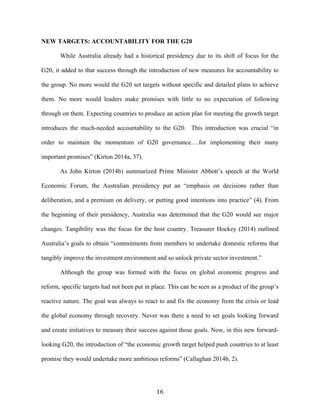

![18
Working Group 2014, 5). Specific to the 2014 deliverables, “the accountability assessment
process will be used to guide adjustments to the growth strategies needed to ensure the G20
meets its collective ambition by 2018” (“Accountability Assessment Framework Going
Forward” 2014, 2). These numerous improved methods of accountability to the G20 will only
strengthen the group and add to its clout in the global arena. While the narrow agenda led to
such impressive outcomes and initiatives, it is important to examine the environment in which
these leaders met that allowed such reform and a shift in thinking.
CURRENT ECONOMIC ENVIRONMENT: A KEY TO SUCCESS
In examining the success of the Australian presidency’s shift of the focus of the G20,
it is important to look at the economic environment in which the summit was held. At the start
of the summit, “G20 leaders [were confronted with] a slowing, struggling economy” (Kirton
2014b, 1) in which advanced countries continued to be “a drag on the world economy,”
without a clear sign of increased growth rates (Drysdale 2014, 1). Although the economy was
not in a crisis, as it was in 2008, these concerns still drove the work of the G20.
Australia’s focus on stimulating stronger economic growth is in response to the
extraordinary need for such growth. As Dr. Peter Drysdale (2014) states, “global growth
between 2004 and 2007 was running at 5.1 per cent, with growth over this period at 2.9 per
cent in advanced economies and 7.9 per cent in emerging markets…From 2011 to 2014,
global growth was 3.4 per cent, with growth of 1.6 per cent in advanced industrial countries
and 5.2 per cent in emerging market economies” (5). These figures demonstrate the global
need to look to the future and promote growth.](https://image.slidesharecdn.com/ad9efdc2-b46b-4ff4-a79e-bf93930c3f90-150529212347-lva1-app6891/85/Senior-Thesis-18-320.jpg)
![19
Even with no current crisis at the time of the summit in Brisbane, the Australian
presidency recognized that “a global steering body is required in the best and worst of times
to deal with both challenges and opportunities” (Hockey 2014). Australia, and the G20, also
recognized that, in comparison to 2008, the world is in decent economic shape. Though
growth rates are slow, the global economy is improving. While Australia would focus
discussion “on the fact that fundamentals across most emerging economies are in better shape
than they were prior to the Global Financial Crisis” they also pledged to “not ignore recent
instability in international financial markets, and, in particular, the impact on emerging market
economies” (Hockey 2014). In doing so, Australia warns about resting on the laurels of an
improving economy and calls for G20 action to prove “it is able to act decisively and
implement policy reforms outside of a global crisis” (Hockey 2014). Australian Treasurer,
Hon. Joseph Hockey (2014), warned G20 countries “complacency is our enemy. We must
resist any temptation to reduce our microeconomic reform efforts at the first sign of growth
and recovery.”
A lack of crisis also stimulates international cooperation. Member countries are more
comfortable when economic conditions are improving and are more open to taking risks and
setting new policy when there is not a crisis to overcome back home. There is no catastrophe
to respond to and fix. The only thing the members can do is look to the future to ensure the
global economy is safeguarded from such a crisis again. This shift in ideals is what Australia
recognized and set out to facilitate.
While some countries were “still grappling with how to restore economic growth,
create jobs and strengthen financial systems, whilst, at the same time, repairing [their]
budgets,” Australia took hold of the opportunity to “refocus on rebuilding fiscal flexibility](https://image.slidesharecdn.com/ad9efdc2-b46b-4ff4-a79e-bf93930c3f90-150529212347-lva1-app6891/85/Senior-Thesis-19-320.jpg)

![21
Crisis and shifted to a proactive future-oriented approach to provide reform and growth
strategies for the future.
Hockey (2014) continued his closing words by emphasizing the Australian
presidency’s recognition that “in the end, our presidency will be judged by just a few things.”
He, and other leaders of the Australian presidency, hoped that
Under our leadership we should have practical actions in place to lift growth and
create jobs. We should aim to shift the dial on world growth…[we] should agree to a
more sustainable approach to fiscal policy that makes our economy globally more
resilient. We should have a financial system that is safer which also supports and
facilitates growth…Under our leadership, Ministers, Governors and Leaders should
find the meetings productive and come away believing the G20 is worth investing in.
We should be remembered not only for helping the G20 deliver its objectives but for
making substantial and lasting improvements to the G20 as a forum. (Hockey 2014)
In the end, Australia successfully achieved its goals and then some. In what has been praised
as a successful summit, Brisbane shifted the focus of the G20, acting as a catalyst to bring the
group from a reactionary body to a proactive and progressive unit. No longer would critics
view the G20 summit as a “talkfest” but recognize it, as Australia always has, as a
fundamental “mechanism of international cooperation” (Hockey 2014).](https://image.slidesharecdn.com/ad9efdc2-b46b-4ff4-a79e-bf93930c3f90-150529212347-lva1-app6891/85/Senior-Thesis-21-320.jpg)
